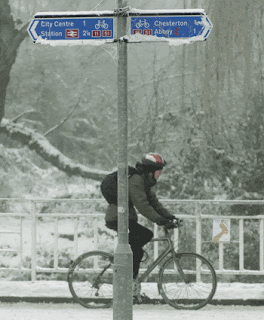 |
Riverside is a popular and important arterial route, forming part of National Cycle Routes 11 and 51 and used by many as a part of their daily commute. Opening of the Riverside Bridge in July 2008 has brought in many additional cyclists, with media reports suggesting that up to 1900 cyclists and pedestrians use the bridge daily. Unfortunately a number of them soon found out the hard way that while major roads in Cambridge were being gritted, major cycle routes were being left untreated. An online petition organised by Robert Oeffner calling on Cambridgeshire County Council to grit all cycle routes in Cambridge rapidly acquired over 1000 signatures and was presented to Council on 26 February 2009. It was duly ignored by our elected representatives, so that come the winter of 2009/10 Riverside and many other cycle routes, were best left to skaters. Mr T, in common with many others, took an undignified tumble whilst out cycling.
 |
| Big, yellow, and yes, on Riverside |
Well it's hard to say for sure, but Oeffner's petition and subsequent comments from the Cambridge Cycling Campaign, Richard Taylor and Riverside Area Residents Association have probably all had an influence. And I wouldn't bet against Mr Cycle Cambridge's Mike Davies having played a part, too. Based on this issue it would seem that democracy in Cambridge is not dead - just very hard of hearing.
















.gif)











